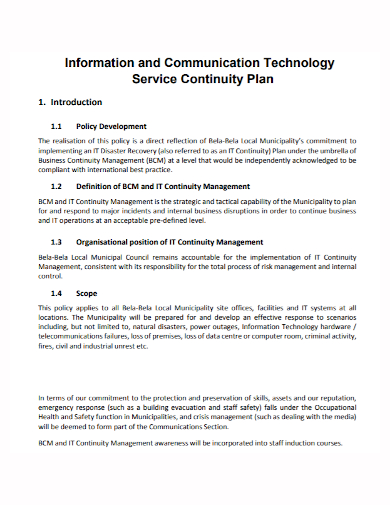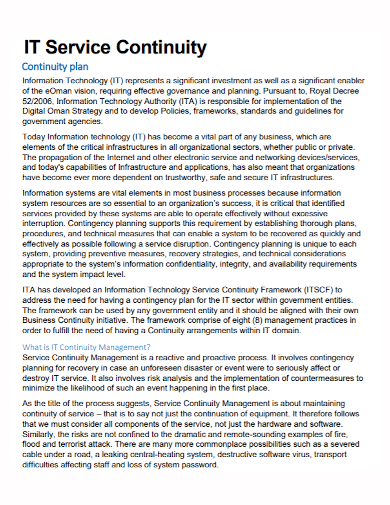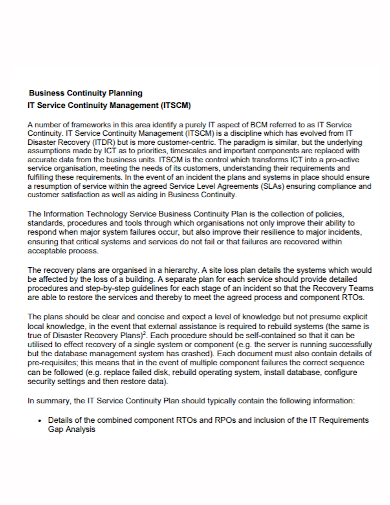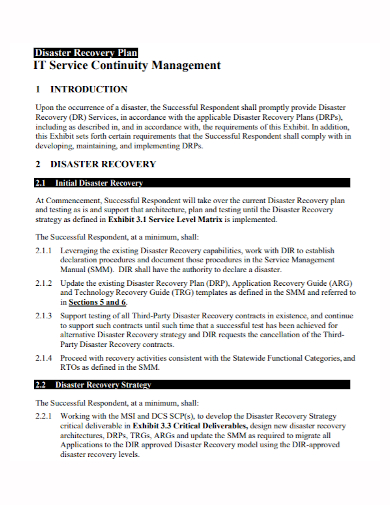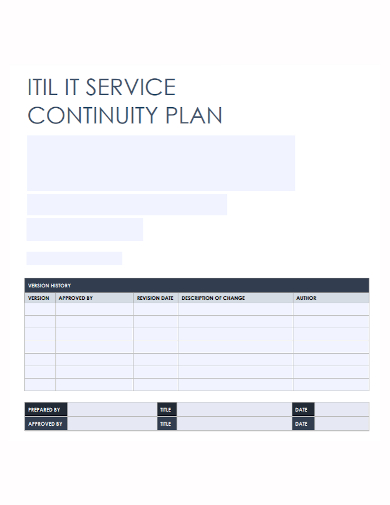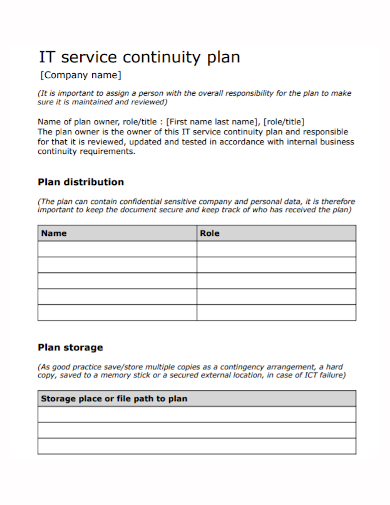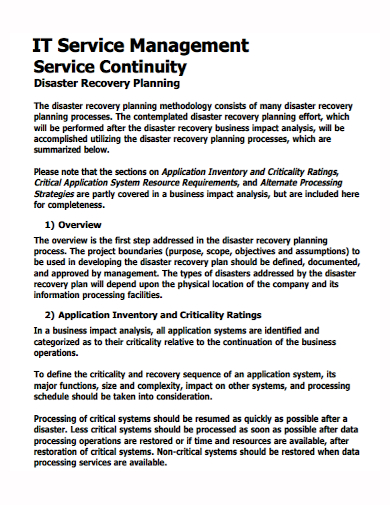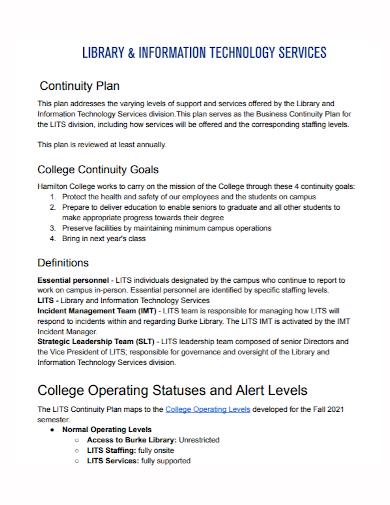Most organizations have committed resources, developed policies, procedures, and tools, and configured their organization and IT infrastructure to maintain critical business processes (Business Continuity Plan) and quickly resume normal operations (Disaster Recovery Plan) during unforeseen events and major outages. Having a strategy in place for these events is not easy; the planning chores are difficult and take a lot of experience and work.
10+ IT Service Continuity Plan Samples
The Information Technology Service Continuity Plan is a set of policies, standards, procedures, and tools that help organizations not only respond to major system failures, but also improve their resilience to major incidents by ensuring that critical systems do not fail or that errors are recovered within suitable process RTO limits. Plans should be straightforward and succinct, and they should assume some amount of expertise but not explicit local knowledge. Each process should be self-contained and able to restore a single system or component. Each document must also include information on pre-requisites, so that in the event that many components fail, the correct sequence may be followed.
1. IT Service Continuity Plan Template
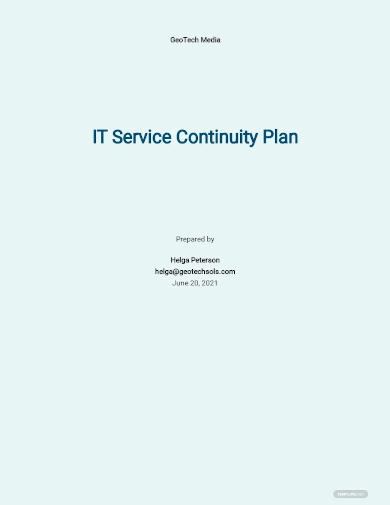
2. IT Communication Service Continuity Plan
3. IT Service Continuity Plan
4. Sample IT Service Continuity Plan
5. IT Service Management Continuity Plan
6. IT Service Continuity Recovery Plan
7. Standard IT Service Continuity Plan
8. IT Company Service Continuity Plan
9. IT Service Disaster Recovery Continuity Plan
10. Library IT Service Continuity Plan
11. IT Service Business Continuity Plan
IT Continuity Planning Trends
- Virtualization – By lowering the amount of IT assets that must be maintained, serviced, and reviewed, virtualization will make the strategy easier to implement. We’ll have fewer devices to worry about, and the RTO can be lowered by fast moving from live to backup virtual machines. Virtual machine deployment over the internet can be an alternative to enabling employees access via their personal home computers, allowing them to be more productive by allowing them to work in an environment they are accustomed with during disruptions.
- Cloud – When software as a service (SaaS), platforms as a service (PaaS), or infrastructure as a service (IaaS) is given via the cloud, a company can prevent and substantially reduce the risk of severe or minor disruptions. The disadvantage for IT is the additional responsibilities involved in managing third-party suppliers through an efficient problem management process and services level approach to ensure that third-party providers have resources in place, failover systems, people, and processes to keep the same standard of service and guarantee data availability regardless of disruptions and outages experienced at the supplier level.
- Mobile devices – Increasing the number of mobile devices in the office will significantly improve business continuity plans. Computer tablets, smartphones, and Blackberries have made it easier to interact during disasters, allowing for more flexibility in workforce recovery alternatives by allowing employees to access corporate applications and connect with coworkers, customers, and vendors from numerous locations. More software created for mobile devices allows users to get critical information during a crisis, such as the progress of recovery, the location of the recovery site, a list of available applications and services, and, lastly, emergency updates.
- Social network – Because of the widespread availability of mobile devices and simple Internet connection, social media platforms such as Twitter, Facebook, and Skype can now be used as part of business continuity and recovery plans.
FAQs
How do you conduct a needs analysis?
Our experts gather requirements for your business through cooperation with key stakeholders from throughout your organization, including priorities, recovery time and point objectives, tolerance for downtime throughout all operational units and systems, as well as training and change management needs.
What is the purpose of a business continuity plan?
A full Business Continuity Plan is established and implemented based on the findings of the discovery and needs analysis to accommodate a variety of scenarios.
To make their response plan effective, organizations should use and evaluate technology. Employees, customers, and vendors all use different platforms, so they need to figure out which one is the most popular. These channels can be utilized to communicate as well as receive information and assistance from external resources in order to improve business continuity and recovery. The disadvantage is that information is circulated more freely outside the business, which might harm its reputation and complicate the crisis communication process.
Related Posts
FREE 7+ Fashion Business Plan Samples in PDF
FREE 10+ Sprint Planning Samples In MS Word | Google Docs | PDF
FREE 10+ Wedding Planning Samples in MS Word | Apple Pages | Powerpoint | PDF
FREE 9+ Monthly Study Planner Samples in PSD | Illustrator | InDesign | PDF
FREE 9+ Sample Curriculum Planning Templates in PDF | MS Word
FREE 10+ Teacher Development Plan Samples in MS Word | Google Docs | Apple Pages | PDF
FREE 10+ Basketball Practice Plan Samples in PDF
FREE 12+ School Business Plan Samples in PDF | MS Word | Apple Pages | Google Docs
FREE 7+ Client Strategic Plan Samples in PDF | MS Word
FREE 11+ Trucking Business Plan Templates in PDF | MS Word | Google Docs | Pages
FREE 7+ Small Hotel Business Plan Samples PDF | MS Word | Apple Pages | Google Docs
FREE 14+ Bakery Business Plans in MS Word | PDF | Google Docs | Pages
FREE 4+ Yearly Lesson Plan Samples in PDF
FREE 50+ Strategic Planning Samples in Google Docs | Pages | PDF | MS Word
FREE 10+ Construction Project Plan Samples in MS Word | Google Docs | Apple Pages | PDF

